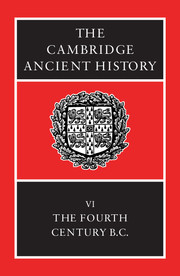Book contents
- Frontmatter
- 1 Sources and their uses
- 2 Sparta as victor
- 3 Persia
- 4 The Corinthian War
- 5 Sicily, 413–368 B.C.
- 6 The King's Peace and the Second Athenian Confederacy
- 7 Thebes in the 360s B.C.
- 8 Regional surveys I: Persian lands and neighbours
- 8a Asia Minor
- 8b Mesopotamia, 482–330 B.C.
- 8c Judah
- 8d Cyprus and Phoenicia
- 8e Egypt, 404–332 B.C.
- 9 Regional surveys II: the West and North
- 10 Society and economy
- 11 The polis and the alternatives
- 12 Greek culture and science
- 13 Dion and Timoleon
- 14 Macedon and north-west Greece
- 15 Macedonian hegemony created
- 16 Alexander the Great Part 1: The events of the reign
- 17 Alexander the Great Part 2: Greece and the conquered territories
- 18 Epilogue
- Chronological Table
- BIBLIOGRAPHY
- Index
- Map 1: Greece and Western Asia Minor
- Map 9: Egypt
- Map 20: Alexanders campaigns
- References
8c - Judah
from 8 - Regional surveys I: Persian lands and neighbours
Published online by Cambridge University Press: 28 March 2008
- Frontmatter
- 1 Sources and their uses
- 2 Sparta as victor
- 3 Persia
- 4 The Corinthian War
- 5 Sicily, 413–368 B.C.
- 6 The King's Peace and the Second Athenian Confederacy
- 7 Thebes in the 360s B.C.
- 8 Regional surveys I: Persian lands and neighbours
- 8a Asia Minor
- 8b Mesopotamia, 482–330 B.C.
- 8c Judah
- 8d Cyprus and Phoenicia
- 8e Egypt, 404–332 B.C.
- 9 Regional surveys II: the West and North
- 10 Society and economy
- 11 The polis and the alternatives
- 12 Greek culture and science
- 13 Dion and Timoleon
- 14 Macedon and north-west Greece
- 15 Macedonian hegemony created
- 16 Alexander the Great Part 1: The events of the reign
- 17 Alexander the Great Part 2: Greece and the conquered territories
- 18 Epilogue
- Chronological Table
- BIBLIOGRAPHY
- Index
- Map 1: Greece and Western Asia Minor
- Map 9: Egypt
- Map 20: Alexanders campaigns
- References
Summary
This chapter was planned independently from CAH III.2, ch. 31, to which the reader may also refer for the period of the Restoration. It is, however, intended to be complementary to CAH IV ch. 3b. That chapter looked at Judah as a part of the Achaemenid empire; here we try to consider its internal development during the period.
The Old Testament books which are relevant are inevitably controversial. It is here assumed (see below, p. 292) that the book of Ezra-Nehemiah was put together, long after the time of the events, from the ‘building blocks’ which included much contemporary documentary material, including a first-person narrative by Nehemiah himself; how much Ezra had to do with his own narrative is more doubtful. The compiler did not aim at a chronological composition, and he tends to build his narrative round the major personalities; gaps and a certain amount of confusion result. We do not believe that this compiler was the same as the author of the Book of Chronicles (below, p. 293), although that used to be the dominant view.
There is little other literary material to help us. Josephus’ survey of the period in the Jewish Antiquities is largely dependent on the edited version of the book of Ezra-Nehemiah in some form or another, and most of his variations are in general likely to arise from his attempts to resolve contradictions than from independent information. Much more help comes from contemporary material, the Elephantine papyri, the Samaria papyri from Wadi Daliyeh, ostraca, coins, seals and other remains of material culture.
- Type
- Chapter
- Information
- The Cambridge Ancient History , pp. 261 - 296Publisher: Cambridge University PressPrint publication year: 1994
References
- 3
- Cited by

